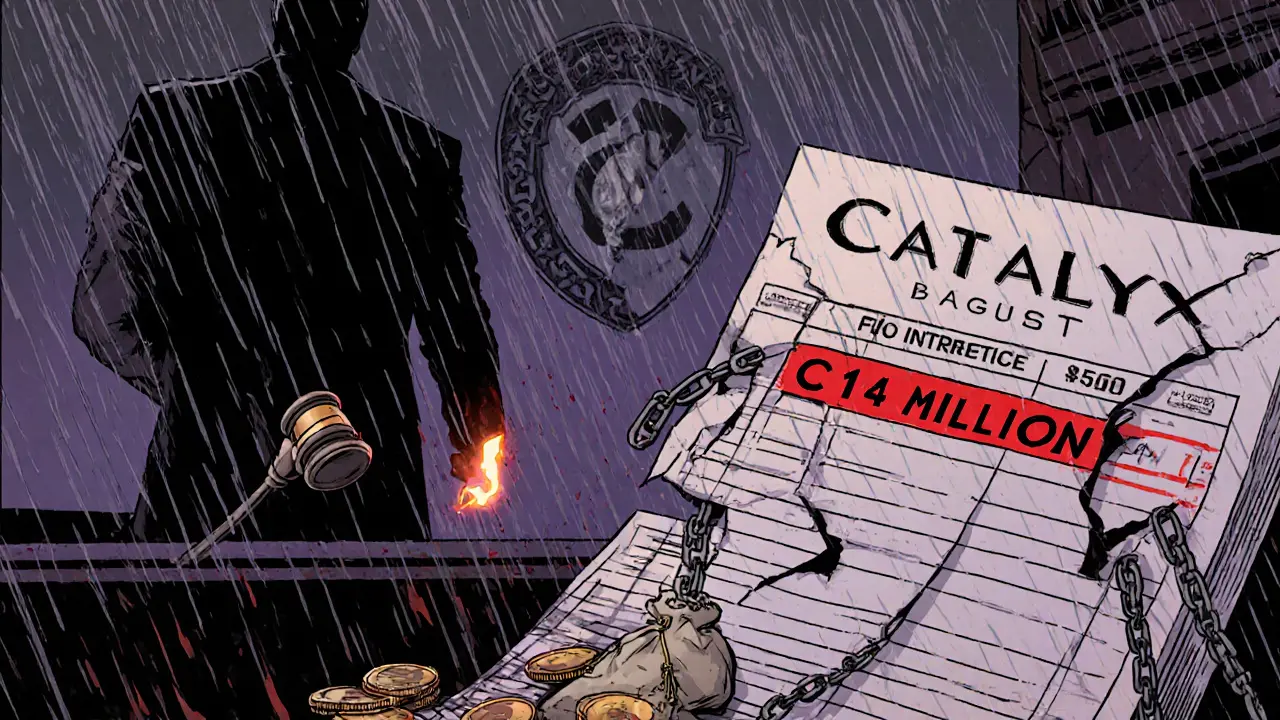Canadian Crypto Exchange Comparison Tool
This tool compares key attributes of Canadian crypto exchanges based on public information available in 2024. Use this to evaluate which exchanges align with your security and operational needs.
Catalyx
0.75% Flat Fee FINTRAC Registered Closed
Assets: ~40
Operational: No
Status: Bankrupt
Known for its flat fee model but collapsed due to fraud allegations and regulatory issues.
Binance Canada
0.10-0.20% Fee Unregistered Operational
Assets: >200
Operational: Yes
Status: Active
Offers wide asset selection but operates under offshore licenses.
Kraken Canada
0.16-0.26% Fee FINTRAC Registered Operational
Assets: ~150
Operational: Yes
Status: Active
Strong regulatory compliance with robust security measures.
Newton
0% Fee FINTRAC Registered Operational
Assets: ~30
Operational: Yes
Status: Active
Spread-based pricing model with strong regulatory oversight.
Key Takeaways
- Always check for regulatory registration (e.g., FINTRAC in Canada).
- Prefer flat fee models over hidden spreads.
- Avoid exchanges with known legal troubles or recent investigations.
- Be cautious of unregistered exchanges even if they seem popular.
- Diversify across multiple platforms and use cold storage for large holdings.
When you hear the name Catalyx crypto exchange review, you probably wonder whether it’s a hidden gem or a cautionary tale. The short answer: it started with promise, grew fast, then collapsed amid fraud allegations and regulatory fallout. This article walks through how the platform was built, what it offered, the red flags that emerged, and the lessons any crypto trader should take away.
What Catalyx Was Supposed to Be
Catalyx was marketed as Canada’s premier digital‑asset trading platform, fully registered with FINTRAC (the Financial Transactions and Reports Analysis Centre of Canada). The exchange promised one‑click trades, 24/7 price tracking, and a sleek interface built for both beginners and seasoned investors.
Behind the Scenes: The Tech Stack
The back‑end was engineered by Quanterall using a modern stack: Elixir and the Phoenix framework for high‑concurrency, SignalR for real‑time updates, and GraphQL as the communication layer. Data lived in TimescaleDB and PostgreSQL, giving the platform fast query speeds and reliable storage.
Trading Offerings, Fees, and Assets
At launch Catalyx listed roughly 40 cryptocurrencies - Bitcoin (BTC), Ethereum (ETH), USDT, ADA, USDC, HBAR, LTC and the usual suspects. The fee model was refreshingly simple: a flat 0.75% per trade with no hidden spread. That meant you knew exactly what you paid, whether you were swapping BTC for ETH or converting CAD to USDT. The platform supported both fiat‑to‑crypto (CAD ↔ crypto) and crypto‑to‑crypto pairs, letting users jump between assets without leaving the interface.
Growth Numbers That Looked Impressive
Early 2021 was a hype‑driven boom for Catalyx. According to internal reports from TechX Technologies Inc., trading volume jumped 1,542% quarter‑over‑quarter in Q12021. In March 2021 alone, volume rose from C$14.88million in February to C$28.44million - a 91% month‑over‑month surge. Deposits grew 163% (C$3.46M to C$9.12M) and revenue rose 76% (C$156.8K to C$275.5K). Those figures painted a picture of a platform gaining rapid traction.
User Experience: From Overwhelming to Intuitive
First‑time users often felt the dashboard was dense, but once the main tabs were familiar the workflow became “one click” as promised. A referral program let users earn up to 20% of a referee’s fees for life - a strong incentive that helped fuel the growth numbers. The built‑in blog kept the community updated on crypto news, platform changes, and trading tips.
Red Flags: Legal Trouble and Internal Fraud
In late 2019, the cracks started to show. The CFO, Jae Ho Lee, allegedly withdrew more than C$14million worth of client assets without permission. The Alberta Securities Commission (ASC) filed a Notice of Hearing on 17July2025 against CatalX CTS Ltd., its CEO Hyuk Jae Park, and Lee, accusing them of fraud and breach of a written undertaking to maintain proper risk controls.
Park claimed he learned of the misconduct on 24Nov2023, yet the company only told the ASC on 21Dec2023 - a near‑month delay that breached regulatory expectations. When Park demanded wallet access in December, Lee stopped responding, prompting legal letters that went unanswered. Operations halted on 28Dec2023, and the exchange entered receivership in January2024.

Why the Platform Collapsed
Besides the alleged fraud, Catalyx relied heavily on liquidity support from Bittrex Global, a major shareholder. When the partnership faltered and the legal cloud thickened, the platform could no longer meet its financial obligations. The ASC highlighted that Catalyx failed to maintain policies to prevent employee misappropriation - a basic internal control that most regulated exchanges have in place.
Safety Concerns for Users
Like any centralized exchange, Catalyx could freeze accounts for suspicious activity or large, unexplained deposits. The platform warned users that frozen accounts might never be unfrozen if regulators deemed the funds illicit. Prior to the fraud scandal there was no evidence of arbitrary freezes, but the eventual bankruptcy meant many users lost access to their assets entirely.
How Catalyx Stacks Up Against Other Canadian Exchanges
| Exchange | Regulatory Status | Assets Offered | Flat Fee | Current Operability |
|---|---|---|---|---|
| Catalyx | FINTRAC‑registered (now bankrupt) | ≈40 | 0.75% | Closed |
| Binance Canada | Unregistered (operates under offshore licences) | >200 | 0.10%‑0.20% | Operational |
| Kraken Canada | FINTRAC‑registered | ≈150 | 0.16%‑0.26% | Operational |
| Newton | FINTRAC‑registered | ≈30 | 0% (spread‑based) | Operational |
The table shows that Catalyx’s flat‑fee model was competitive, but its regulatory collapse made it a risky choice. Other exchanges either rely on spread pricing or have broader asset lists, but they remain active and compliant.
Quick Checklist - Should You Trust a New Exchange?
- Confirm registration with a local regulator (FINTRAC in Canada, FCA in the UK, etc.).
- Look for transparent fee structures - flat fees are easier to verify than hidden spreads.
- Verify corporate governance: board members, audited financials, and clear policies on employee access to client wallets.
- Assess liquidity partners - reliance on a single external provider can be a single point of failure.
- Read recent legal news; a hearing or investigation is a red flag.
What the Catalyx Collapse Teaches Investors
First, centralized exchanges need strong internal controls. A single rogue employee can jeopardize millions. Second, regulatory compliance isn’t just a checkbox; timely reporting of breaches is mandatory. Third, diversify your holdings - never keep all assets on one platform. Finally, keep an eye on liquidity sources; if a partner pulls out, the exchange may crumble faster than you expect.
Next Steps for Former Catalyx Users
If you still have pending claims, the receivership process in Canada typically involves filing a proof of claim with the appointed liquidator. Check the court‑issued notice for filing deadlines (usually within 90days of the receivership order). Meanwhile, consider moving any remaining crypto to a hardware wallet or a reputable, regulated exchange.
Frequently Asked Questions
Is Catalyx still operational?
No. Catalyx entered receivership in January2024 and has been shut down ever since. Users can no longer deposit, trade, or withdraw.
Can I recover my lost funds?
Recovery depends on the liquidation process. Creditors, including individual users, must submit a proof‑of‑claim to the court‑appointed receiver. The outcome is uncertain and may result in partial or full loss.
What made Catalyx’s fee model attractive?
A flat 0.75% per trade with no spread meant traders could calculate costs upfront, unlike many platforms that hide fees in the spread.
How does FINTRAC registration protect users?
FINTRAC registration requires AML/KYC procedures, periodic reporting, and adherence to risk‑management standards, which reduces the chance of unchecked fraud.
Should I trust other Canadian exchanges?
Check each exchange’s regulatory status, audit reports, and user reviews. Platforms like Kraken Canada and Newton have maintained compliance and continue to operate.





tim nelson
August 9 2025Reading through the Catalyx saga really drives home how crucial internal controls are for any exchange. When a single employee can access client wallets, the whole platform becomes a house of cards. Regulators expect segregation of duties, but Catalyx apparently skipped that step. The fallout shows that even a registered exchange can fall apart without proper governance. It’s a reminder to treat custodial services with the same scrutiny we apply to banks.
Zack Mast
August 13 2025Sounds like another classic crypto crash.
Dale Breithaupt
August 17 2025Key takeaway: never keep all your assets on one platform. Spread your holdings across a reputable exchange and a hardware wallet for safety.
Rasean Bryant
August 21 2025It’s encouraging to see that the industry is learning from Catalyx’s mistakes. More exchanges are tightening up their AML/KYC procedures, which ultimately protects traders.
Angie Food
August 24 2025Sure, but flat fees aren’t a silver bullet if the back‑office is a mess.
Jonathan Tsilimos
August 28 2025The comparative table underscores the importance of regulatory registration. FINTRAC‑registered platforms such as Kraken and Newton maintain operational resilience, whereas unregistered entities lack oversight.
jeffrey najar
September 1 2025Agreed. When evaluating a new exchange, cross‑check its licensing status and read the latest regulator filings before depositing any capital.
Rochelle Gamauf
September 5 2025One might argue that Catalyx’s flat‑fee model was merely a marketing veneer masking deeper operational deficiencies.
Jerry Cassandro
September 9 2025Exactly, the fee structure felt attractive, but without transparent audits you’re essentially paying for uncertainty.
Parker DeWitt
September 13 2025The rise and fall of Catalyx also highlights how liquidity partnerships can become single points of failure. When Bittrex pulled back, Catalyx lost a crucial lifeline, accelerating its demise. It’s a cautionary tale for any platform relying heavily on one external provider. Diversification isn’t just for assets; it applies to liquidity sources too. Moreover, the delayed reporting to ASC shows a troubling lack of compliance culture. Strong governance demands timely disclosures, not months‑long silences. Users should demand clear escalation procedures for internal fraud alerts. The crypto space still suffers from a dearth of standardized internal control frameworks. As the market matures, we’ll likely see more rigorous audits becoming a prerequisite for registration. Until then, keep a healthy skepticism and always have an exit plan. Remember, an exchange can disappear overnight, and you’ll be left scrambling for your assets.
Allie Smith
September 16 2025Philosophically, the Catalyx episode reminds us that trust in technology is only as strong as the human ethics behind it. Without integrity, even the slickest code is doomed.
Lexie Ludens
September 20 2025True, the tech stack was impressive, but ethics can’t be compiled into code.
Aaron Casey
September 24 2025From a compliance perspective, the lack of segregation of duties violates core AML framework principles, specifically the “Know Your Employee” (KYE) component, which mandates monitoring of insider access.
Leah Whitney
September 28 2025Good point. Adding KYE audits could have flagged the CFO’s unauthorized withdrawals earlier.
Lisa Stark
October 2 2025Balancing risk and reward is essential; Catalyx tipped too far toward growth without solid risk controls.
Logan Cates
October 6 2025When an exchange promises simplicity, it often glosses over the underlying complexity that can doom it. Catalyx marketed a one‑click trading experience, yet the infrastructure required massive real‑time order matching, which demands both robust hardware and meticulous software engineering. The choice of Elixir and Phoenix was sound for concurrency, but without a solid governance layer, the code was vulnerable to misuse. Their reliance on a single liquidity provider created a bottleneck; once that provider withdrew support, the order book could not sustain itself. The CFO’s alleged misappropriation of C$14 million illustrates the perils of inadequate internal audit trails. A proper separation between custodial operations and corporate finance is mandatory, yet Catalyx appeared to blur those lines. Moreover, the delayed notification to FINTRAC undermined regulatory trust, showing a disregard for compliance timelines. Such delays can trigger heavier penalties and erode user confidence rapidly. Users often overlook the importance of transparent reporting, focusing instead on flashy UI and low fees. However, the fee model, while attractive, cannot compensate for potential loss of assets due to fraud. The case also reveals how rapid expansion can outpace internal controls, leading to governance gaps. A prudent exchange should scale its compliance functions in lockstep with user growth. Additionally, the lack of a clear disaster recovery plan left users stranded when operations halted. The receivership process now leaves many investors uncertain about recovery prospects. In hindsight, the warning signs-rapid volume spikes, aggressive referral incentives, and a singular liquidity partner-should have prompted deeper scrutiny. Ultimately, Catalyx serves as a textbook example of why decentralized custody or hybrid models might be safer for traders. By diversifying custody and demanding third‑party audits, the crypto ecosystem can mitigate such catastrophic failures in the future.
Shelley Arenson
October 9 2025💡 Great rundown! It really puts the whole mess into perspective.
Joel Poncz
October 13 2025i cant believe how many ppl fell for the flat fee hype without checkin the back end.
Kris Roberts
October 17 2025One thing to remember is that crypto markets thrive on hype, but sustainable platforms focus on security and transparency.
lalit g
October 21 2025From an Indian perspective, we see similar patterns where rapid growth outpaces regulation, making vigilance key.
Reid Priddy
October 25 2025Honestly, the whole “regulated” label is often just a marketing ploy; users should do their own deep‑dives regardless.